A Case Study for Stability Analysis of a Toppling Bank Slope with Fault Fracture Zones Developed under the Action of Bridge Loads and Reservoir Water
Abstract
1. Introduction
2. Overview of the Study Area
2.1. Topography
2.2. Bridge Construction Schemes for the Research Area
2.3. Geological Characteristics
2.3.1. Lithology
2.3.2. Fault Fracture Zones
2.3.3. Hydrogeological Conditions
2.3.4. Geological Structure Characteristics of the Bank Slope
3. Methodology
3.1. Working Conditions
- Natural working conditions: the simulation and analysis of the natural bank slope with bridge operation.
- Rainstorm conditions: The simulation and analysis of the bank slope under heavy rainfall with bridge operation;
- Rainstorm + earthquake conditions: the simulation and analysis of the bank slope under seismic loads during heavy rainfall with bridge operation.
3.2. GeoStudio Theory and Two-Dimensional Model Establishment
3.3. 3DEC Theory and Three-Dimensional Model Establishment
- The calculation model is mainly composed of the bank slope rock mass and the relevant units of the bridge foundations. The loads of the bridge foundations are applied in the form of static loads on the bridge foundations units—the maximum vertical loads are applied on the surface of bridge piers, while the horizontal loads are applied on the side of the bridge piers along the bridge direction.
- The infiltration forces generated by rainfall and the fluctuating water level are loaded for calculation after conversion. Especially, the range of the fluctuating water level is determined by setting the water level lines in the model.
- The rock mass on the bank slope satisfies the ideal elastic–plastic constitutive relationship and the yield condition is the Mohr Coulomb condition, while Coulomb slip models are set for structural planes such as rock layers and faults.
- The mechanical parameter properties are assigned to the rock mass and structural plane, while the boundaries for the displacement and stress boundaries are set around the model, and the in situ stress is set inside the model.
4. Research Results
4.1. Two-Dimensional Limit Equilibrium Analysis of Toppling Bank Slope with Fault Fracture Zones Developed under Bridge Loads
4.1.1. Potential Failure Mode of Bank Slope under Bridge Loads
4.1.2. Analysis of Calculation Results of Two-Dimensional Numerical Simulation
- Under the natural bank slope state, all the sliding surfaces are stable under the natural and rainstorm conditions, which is consistent with the qualitative results, indicating that the selection of rock and soil mass parameters is reasonable.
- In Scheme 1, potential sliding surfaces 1 and 4 cannot meet the safety requirements in all the conditions, while only sliding surface 4 did not meet stability requirements in all the working conditions in Scheme 2. Therefore, Scheme 2 has the higher safety reserve and can provide sufficient assurance for the stability of the bank slope.
- The potential sliding surfaces Slips 1–4 are located above the reservoir water and groundwater as non-wading landslides. The stability results are not affected by the periodic fluctuating water level, while the stability of Slip 5 is slightly affected by that.
- The stability coefficient shows the law of the natural working condition > rainstorm working condition > rainstorm + earthquake working condition. Therefore, it is greatly affected by rainfall infiltration and seismic forces.
4.2. Three-Dimensional Discrete Element Analysis of Toppling Bank Slope with Fault Fracture Zones Developed under Bridge Loads
4.2.1. Displacement Analysis under Different Working Conditions
4.2.2. Stress and Strain Analysis under Different Working Conditions
4.2.3. Plastic Zone and Stability Coefficient Analysis under DifferentWorking Conditions
5. Discussion
5.1. Mechanism of the Deformation and Failure of the Toppling Bank Slope with Fault Fracture Zones Developed under the Action of Bridge Loads and Reservoir Water
5.1.1. Incentive Mechanism of Bridge Loads and Reservoir Water on the Deformation and Failure of the Bank Slope
5.1.2. Influence of Bridge Loads and Reservoir Water on the Deformation of Toppling Rock Mass
5.1.3. Influence of Fault Fracture Zones on the Stability of the Toppling Bank Slope
5.2. Determination of the Optimal Bridge Scheme
- Engineering Geological Conditions
- 2.
- Calculation Results of the Stability Numerical Evaluation Model
5.3. Limitations of the Stability Numerical Evaluation Model
- In the numerical simulation calculations, the bridge loads are applied by adding the static loads of the bridge structures in the position of the bridge foundations, but there is no comparison between the difference between the equivalent concentrated force or equivalent surface force and dynamic load on the simulation results.
- Due to one of the research objectives being the stability of the bank slope under bridge loads, except for the selection of the bridge foundations layout based on the simulation result, we did not underscore its relevance to bridge safety and engineering design such as the bridge design, construction, and maintenance.
- This study mainly discusses the effects of bridge loads and reservoir water on the fault fracture zones developed on the stability of the bank slope through the evaluation model, while there are other factors affecting the stability without consideration, which may cause differences between the results and actual conditions.
- The geotechnical parameters in the paper refer to relevant engineering and simulation parameters in the region, and the rationality is verified by comparing the calculation results with qualitative analysis. However, it is inadequate in the analysis of parameters, which can be further addressed via indoor testing or simulation experiments.
6. Conclusions
- The geological structure of the bank slope is complex, with active fault fracture zones and small-scale secondary ones, while the bank slope developed with toppling deformation with the degree of deformation varies in depth. Therefore, factors such as the bridge loads, reservoir water, and rainfall can affect the stability of the bank slope, and they will have a significant impact on the operation of the reservoir area and the safety of bridge structure once the failure of slope occurs.
- The simulation results show that the rock mass under the bridge foundations was compressed, while the foot of the slope was affected by water storage, both prone to deformation, forming stress concentration zones and plastic zones. The bridge loads accelerated the bending tensile deformation of the toppling rock mass on the bank slope; the groundwater level on the bank slope rose after the reservoir impoundment and rainfall, which reduced the strength of the rock and soil, accelerating the penetration of the plastic zone. Therefore, the combined effect of the bridge loads and reservoir water changed the original stress state of the bank slope, providing conditions for its deformation.
- The fault fracture zones are important geological structures that affect the stability of the bank slope. The low impermeability of the fault fracture zones motivated the accelerated infiltration of rainfall and reservoir water, reduced the mechanical properties of the rock mass within and round the zones, accelerating the failure of the rock mass under the bridge foundations; the rock mass within the zones has the characteristics of low strength and variability, which led to the local stress in the upper part of the fault fracture zones and accelerated the expansion of the original cracks in the rock mass within the zones; the toppling deformation and bridge loads caused stress concentration in the upper part of the fault fracture zones, motivating the displacement of the rock mass inside the zones, accelerating the holing-through of the potential sliding surface and reducing the overall stability of the bank slope.
- The results achieved in the study show that the numerical calculation model based on GeoStudio and 3DEC provides an effective tool for investigating the stability, deformation and failure mechanism of the bank slope in the study, and it offers references for the selection of the layout positions of the bridge foundations.
Author Contributions
Funding
Data Availability Statement
Conflicts of Interest
References
- Song, Z.Q.; Huang, J.; Liu, X.L.; Zhang, L.J.; Wang, E.Z. Dynamic Response Analysis of Rock Bank Slope of a Bridge Across Jinsha River Under Earthquakes. Adv. Eng. Sci. 2021, 53, 45–53. (In Chinese) [Google Scholar] [CrossRef]
- Fei, L.; Guan, H.C.; Wang, S.; Huang, R.Y.; Sun, C.W. Analysis on bank slope stability of railway bridge foundation A double-line bridge of Guizhou-Chongqing railway in Yungui Plateau as a case study. Plateau Sci. Res. 2019, 3, 44–51,60. (In Chinese) [Google Scholar] [CrossRef]
- Ye, Z.Y.; Wang, M.; Mei, S.H.; Lin, M.Y.; Xiao, Y.J. Stability Analysis for Anchored Foundation Slope of Higher Bank Side of One Yangtze River Bridge. Min. Metall. Eng. 2021, 41, 11–15. (In Chinese) [Google Scholar] [CrossRef]
- Wang, Z.H.; Zhou, H.L. Shear strength characteristics of soils on bank slope of bridge foundation. Chin. J. Geotech. Eng. 2023, 45, 193–196. (In Chinese) [Google Scholar] [CrossRef]
- Peng, W.Z.; Zhao, M.H.; Yang, C.W. Study on Slope Stability under Loads Induced by Pile Foundations Based on Finite Element Limit Analysis. J. Hunan Univ. Nat. Sci. 2022, 49, 189–197. (In Chinese) [Google Scholar] [CrossRef]
- Deendayal, R.; Muthukkumaran, K.; Sitharam, T.G. Response of Laterally Loaded Pile in Soft Clay on Sloping Ground. Int. J. Geotech. Eng. 2016, 10, 580–588. [Google Scholar] [CrossRef]
- Deendayal, R.; Muthukkumaran, K.; Sitharam, T.G. Effect of Slope on p-y Curves for Laterally Loaded Piles in Soft Clay. Geotech. Geol. Eng. 2018, 36, 1509–1524. [Google Scholar] [CrossRef]
- Chen, C.C.; Shih, B.J.; Jeng, C.J. Case Study on Performance Monitoring and Stability Analysis of Baishihu Suspension Bridge and Side Slope. J. Civ. Eng. Manag. 2022, 28, 81–92. [Google Scholar] [CrossRef]
- Haider, M.; Yuan, S.F.; Li, T.L.; Liu, Y.P.; Lawrence, D.D.; Khan, R.K.M. Stability prediction of the toppling rock slope on the Heihe reservoir bank using discontinuous deformation analysis. Environ. Earth Sci. 2015, 82, 16. [Google Scholar] [CrossRef]
- Ning, Y.B.; Tang, H.M.; Zhang, G.C.; Smith, J.V.; Zhang, B.C.; Shen, P.W.; Chen, H.J. A complex rockslide developed from a deep-seated toppling failure in the upper Lancang River, Southwest China. Eng. Geol. 2021, 293, 106329. [Google Scholar] [CrossRef]
- Dong, M.L.; Zhang, F.M.; Lv, J.Q.; Hu, M.J.; Li, Z.N. Study on deformation and failure law of soft-hard rock interbedding toppling slope base on similar test. Bull. Eng. Geol. Environ. 2020, 79, 4625–4637. [Google Scholar] [CrossRef]
- Huang, D.; Ma, H.; Meng, Q.J.; Song, Y.X. Study on Toppling Mechanism and Affecting Factors of Anti-dip Rock Slopes with Soft-hard Interbedded structure. J. Eng. Geol. 2021, 29, 602–616. [Google Scholar] [CrossRef]
- Zhang, H.N.; Xu, X.Y.; Zheng, Y.; Li, H.; Guo, H.S. Experimental and numerical study of the mechanism of block-flexure toppling failure in rock slopes. Bull. Eng. Geol. Environ. 2022, 81, 63. [Google Scholar] [CrossRef]
- Yang, H.; Wei, Y.F.; Pei, X.J.; Zhang, Y.Y. Centrifugal test study of fracture evolution characteristics of anti-dip rock slope with steep and gently dipping structural plane. Rock Soil Mech. 2022, 43, 1215–1225. [Google Scholar] [CrossRef]
- Haghgouei, H.; Kargar, A.R.; Amini, M.; Esmaeili, K. An analytical solution for analysis of toppling-slumping failure in rock slopes. Eng. Geol. 2020, 265, 105396. [Google Scholar] [CrossRef]
- Kilic, R.; Ulamis, K. Toppling and sliding in volcanic bimrocks around Bayrakli (Izmir, Turkey). J. Mt. Sci. 2020, 17, 492–500. [Google Scholar] [CrossRef]
- Sarfaraz, H. An Analytical Solution for Analysis of Block Toppling Failure Using Approach of Fictitious Horizontal Acceleration. J. Min. Sci. 2021, 57, 202–209. [Google Scholar] [CrossRef]
- Azarafza, M.; Akgun, H.; Ghazifard, A.; Asghari-Kaljahi, E. Key-block based analytical stability method for discontinuous rock slope subjected to toppling failure. Comput. Geotech. 2020, 124, 103620. [Google Scholar] [CrossRef]
- Ardestani, A.; Amini, M.; Esmaeili, K. A two-dimensional limit equilibrium computer code for analysis of complex toppling slope failures. J. Rock Mech. Geotech. Eng. 2021, 13, 114–130. [Google Scholar] [CrossRef]
- Dai, Z.H.; Hu, Z.Q.; Yin, X.T.; Wu, Z.J. Deformation stability analysis of gentle reverse inclined layer-like rock slope under engineering load. Rock Soil Mech. 2018, 39, 412–418+424. [Google Scholar] [CrossRef]
- Huang, J.; Tang, S.; Liu, Z.; Zhang, F.; Dong, M.; Liu, C.; Li, Z. A Case Study for Stability Analysis of Toppling Slope under the Combined Action of Large Suspension Bridge Loads and Hydrodynamic Forces in a Large Reservoir Area. Water 2023, 15, 4037. [Google Scholar] [CrossRef]
- Azarfar, B.; Ahmadvand, S.; Sattarvand, J.; Abbasi, B. Stability Analysis of Rock Structure in Large Slopes and Open-Pit Mine: Numerical and Experimental Fault Modeling. Rock Mech. Rock Eng. 2019, 52, 4889–4905. [Google Scholar] [CrossRef]
- Liu, Y.; Yu, L.; Song, W.; Yang, T. Three-Dimensional Analysis of Complex Rock Slope Stability Affected by Fault and Weak Layer Based on FESRM. Adv. Civ. Eng. 2019, 2019, 6380815. [Google Scholar] [CrossRef]
- Mehdi, K.; Mohammad, A.; Reza, D. A Qslope-based empirical method to stability assessment of mountain rock slopes in multiple faults zone: A case for North of Tabriz. MethodsX 2022, 9, 101718. [Google Scholar] [CrossRef]
- Kumar, M.; Krishnaveni, V.; Muthukumar, S. Geotechnical Investigation and Numerical Analysis of Slope Failure: A Case Study of Landslide Vulnerability Zone in Kolli Hills, Tamil Nadu. J. Geol. Soc. India 2021, 97, 513–519. [Google Scholar] [CrossRef]
- Raghuvanshi, T.K. Plane failure in rock slopes—A review on stability analysis techniques. J. King Saud Univ. Sci. 2019, 31, 101–109. [Google Scholar] [CrossRef]
- Perea, H.; Gracia, E.; Martinez-Loriente, S.; Bartolome, R.; Gomez de la Pena, L.; de Mol, B.; Moreno, X.; Lo Iacono, C.; Diez, S.; Tello, O.; et al. Kinematic analysis of secondary faults within a distributed shear-zone reveals fault linkage and increased seismic hazard. Mar. Geol. 2018, 339, 23–33. [Google Scholar] [CrossRef]
- Claire, B.; Yves, G.; Isabelle, M.; Luca, M.; Didier, S. Pore network properties of sandstones in a fault damage zone. Mar. Geol. 2018, 110, 24–44. [Google Scholar] [CrossRef]
- Kincal, C. Fault-controlling safe slope design procedure in an open-pit mine case study: Tunçbilek-Kütahya (Turkey) coal field. Arab. J. Geosci. 2021, 14, 91. [Google Scholar] [CrossRef]
- Ren, S.L.; Tao, Z.G.; He, M.C.; Pang, S.H.; Li, M.N.; Xu, H.T. Stability analysis of open-pit gold mine slopes and optimization of mining scheme in Inner Mongolia, China. J. Mt. Sci. 2020, 17, 2997–3011. [Google Scholar] [CrossRef]
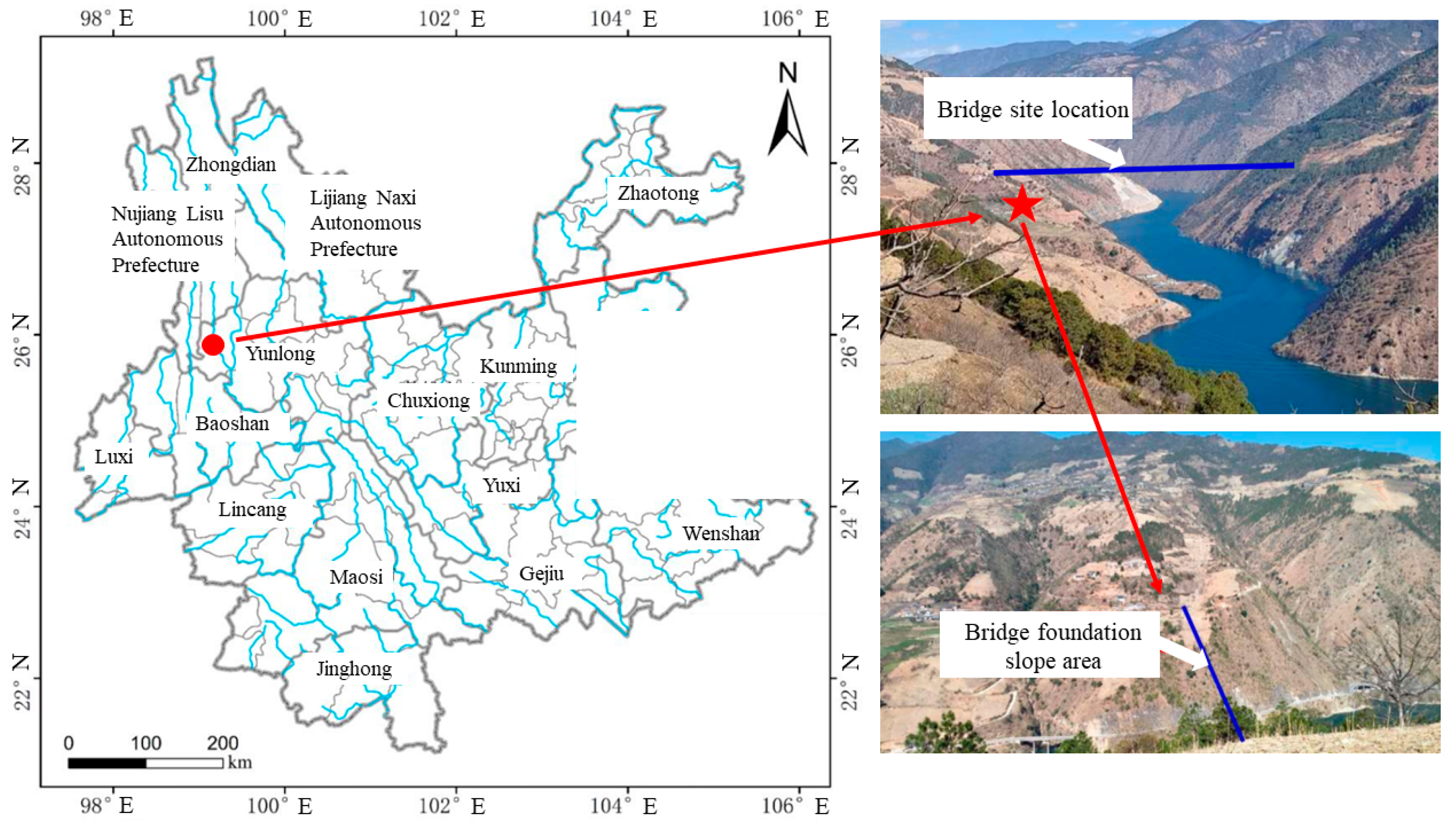

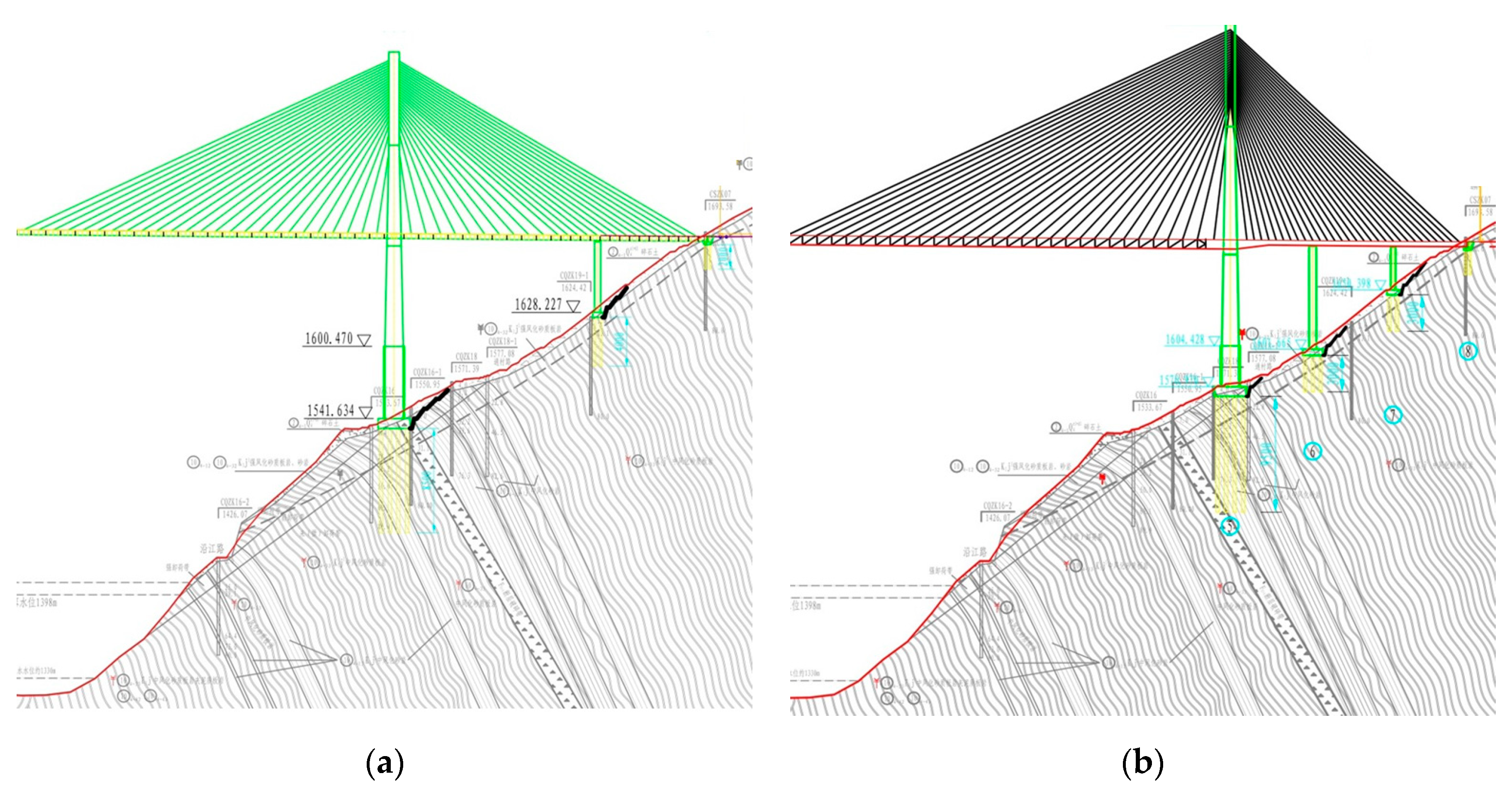


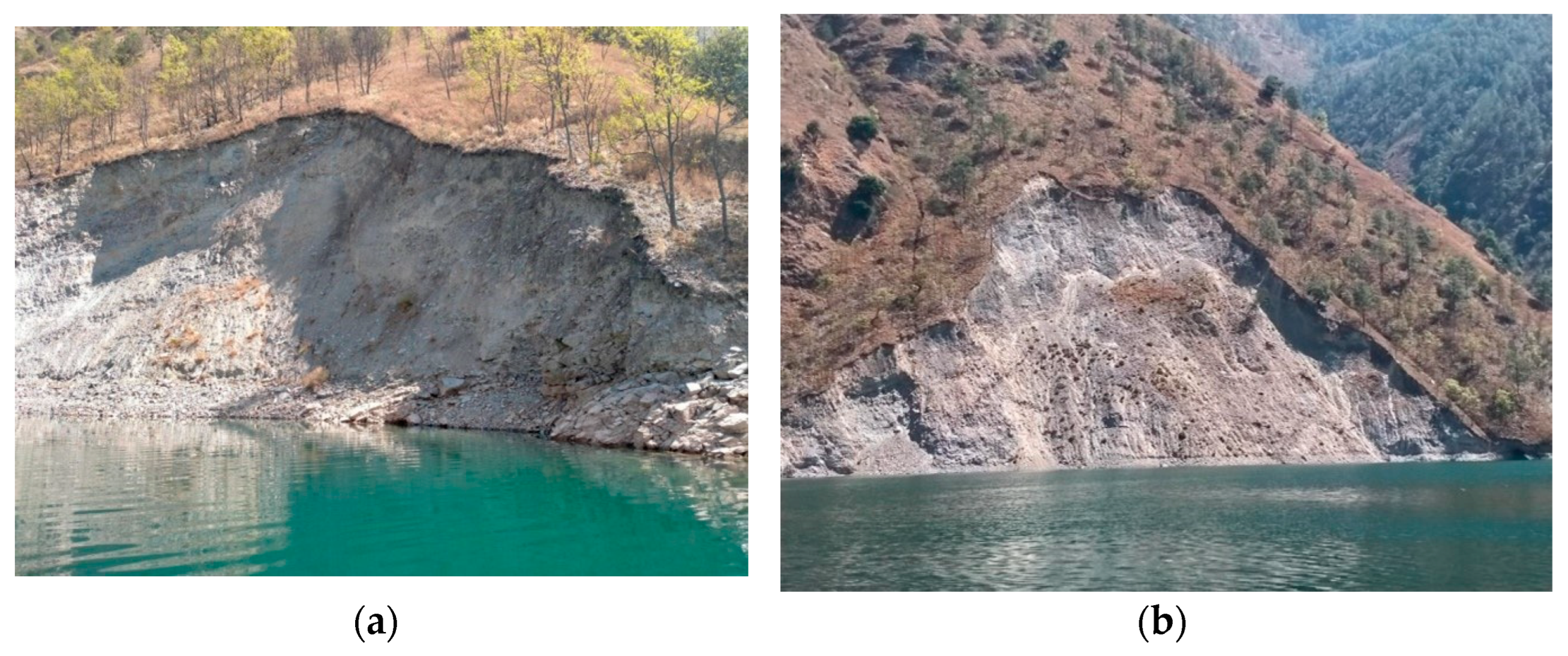


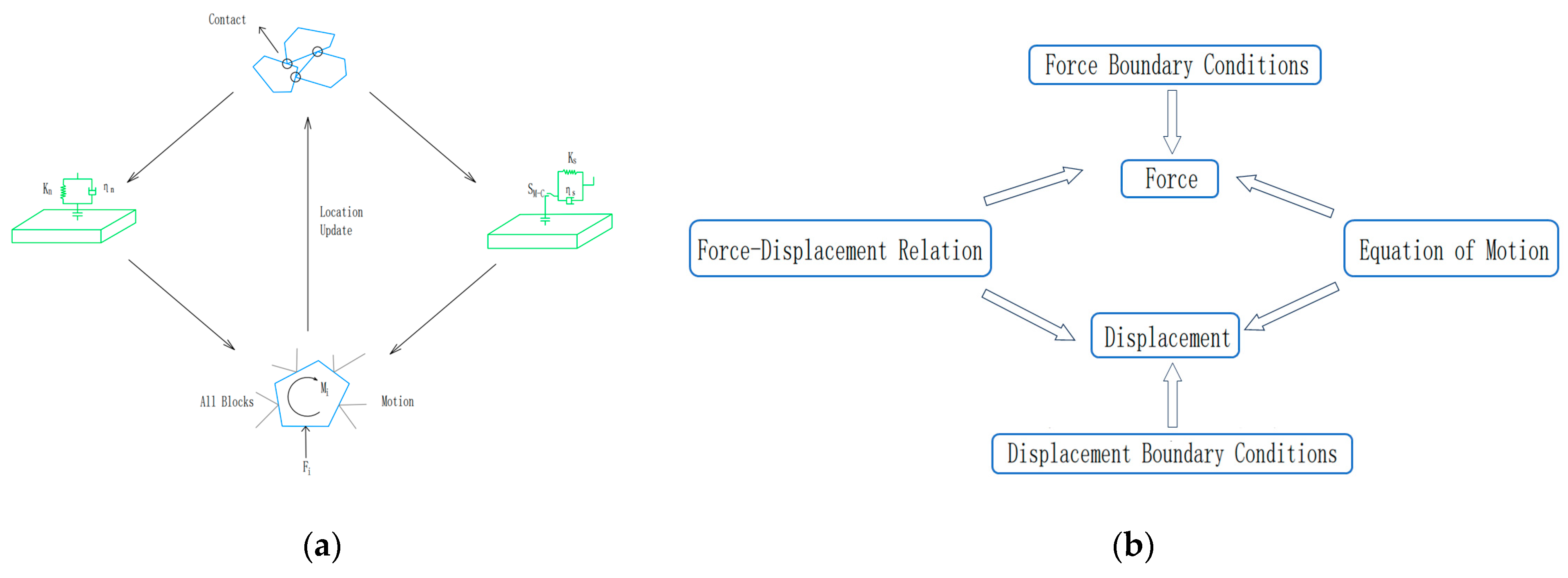

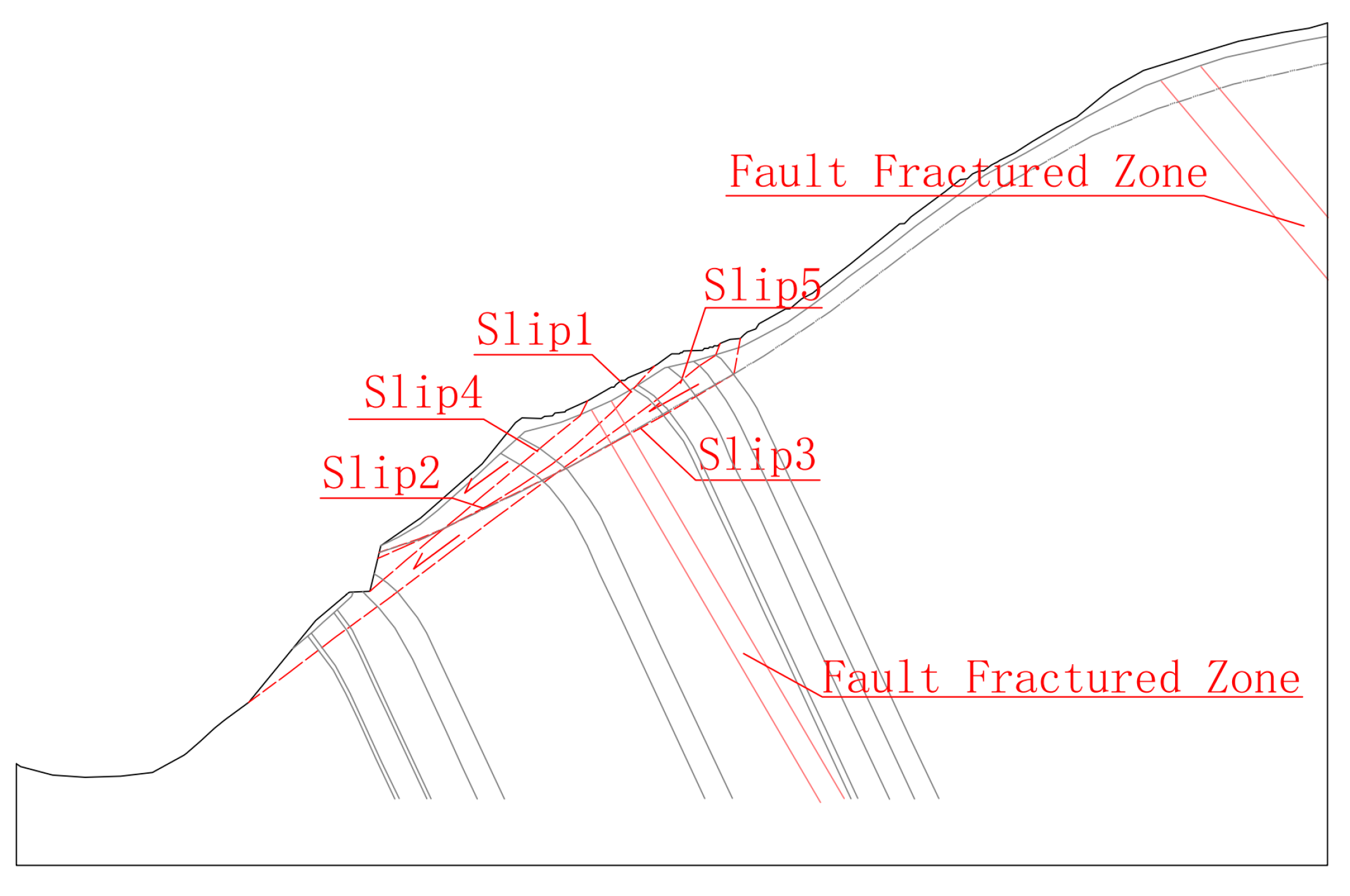

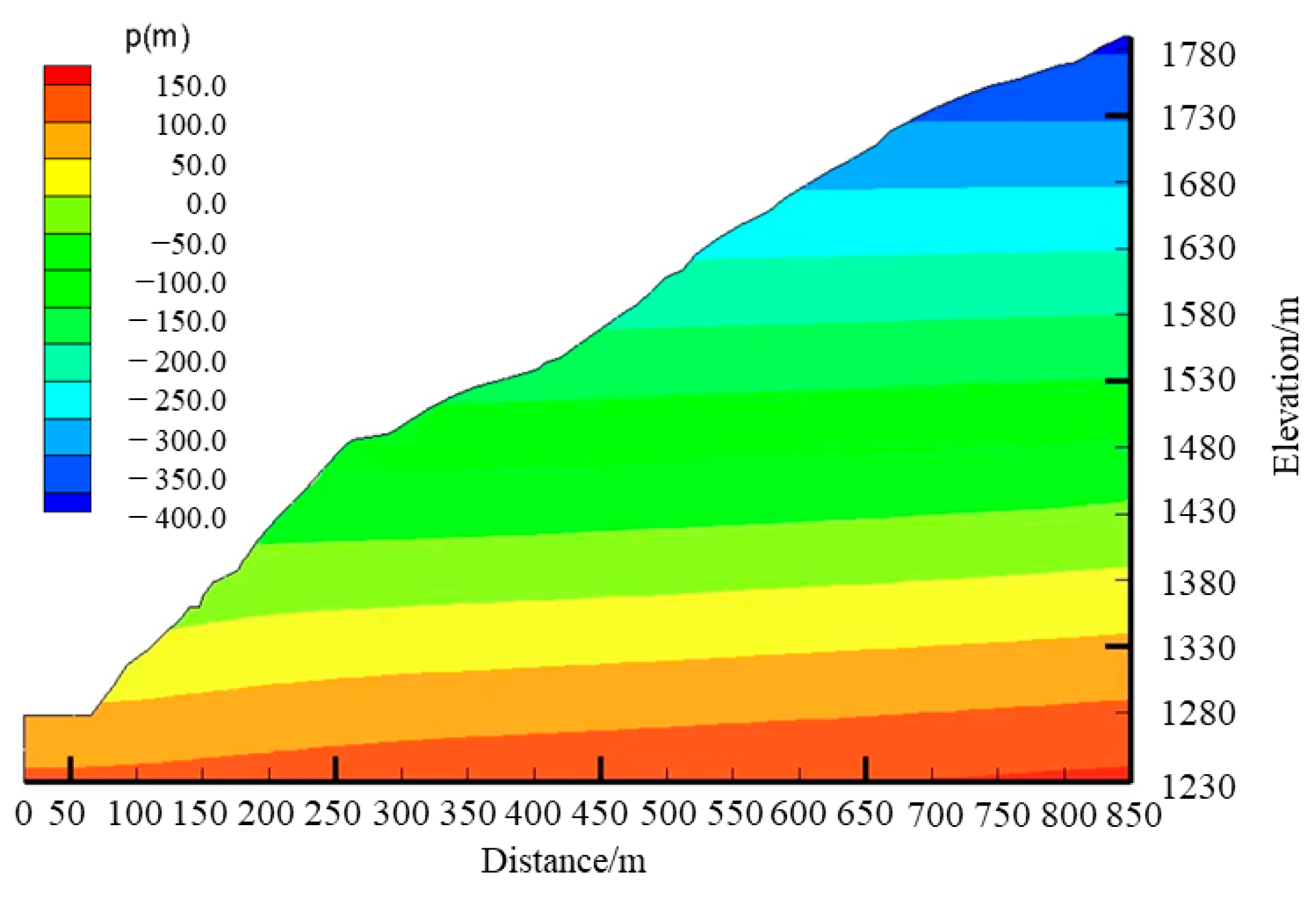







| Bridge Scheme and the Bridge Span | Pier/Abutment Name | Transverse Bridge Width/m | Pile Foundation Length/m | Axial Force/kN | Axial Compressive Bearing Capacity per Linear Meter of a Single Pile with a Single Width/kN | Horizontal Force along the Bridge Direction/kN | Horizontal Force along the Bridge Direction with Single Width/kN |
|---|---|---|---|---|---|---|---|
| Scheme 1 | Main pier | 40.0 | 85.0 | 1,053,351 | 216 | 68,584 | 1715 |
| Auxiliary pier | 11.2 | 30.0 | 39,027 | 111 | 6233 | 556 | |
| Abutment | 12.8 | 20.0 | 53,702 | 172 | 0 | 0 | |
| Scheme 2 | Main pier | 40.0 | 95.0 | 1,679,116 | 216 | 7187 | 180 |
| Auxiliary pier (adjacent to the main pier) | 16.5 | 30.0 | 127,246 | 205 | 0 | 0 | |
| Auxiliary pier (near abutment pier) | 16.5 | 30.0 | 62,101 | 150 | 0 | 0 | |
| Abutment | 11.8 | 20.0 | 74,444 | 172 | 0 | 0 |
| Erathem | System | Stratum Code | Strata Thickness (m) | Lithological Characteristics |
|---|---|---|---|---|
| Cenozoic Erathem | Quaternary System | Q4 | <50.0 | Silty clay and gravel soil |
| Mesozoic Erathem | Cretaceous System | K1j1 | / | Sandy slate, muddy sandstone and metamorphic sandstone |
| Type | Description | |
|---|---|---|
| Fault Mud | Gray white, plastic hard plastic, interbedded with fault breccia, with a general particle size of 2.0–3.0 cm, content of about 30% gray white, thickness of about 5.30 m. | |
| Fault Breccia | The thickness of the fractured zone of the F11 fault is about 24.1 m. The characteristics of the rock mass in the fractured zone of the fault vary from top to bottom with the depth of the bank slope. | At the depth of 7.0–15.0 m, it is strongly weathered slate, gray to light gray. The rock structures are damaged, the stratification is not visible, and the joint fissures are well developed. The rock core are mostly fragmented, and the fissure surfaces are filled with fault mud. |
| At the depth of 15.0–25.0 m, it is strongly weathered sandstone with invisible stratification. The rock cores are mostly fragmented with a diameter of 3.0–5.0 cm generally. | ||
| At a depth of 25.0–29.1 m, it is strongly weathered slate, gray to deep gray, with invisible stratification. The rock cores are mostly fragmented, while a small amount of them are short columns. | ||
| At a depth of 29.1–3.1 m, it is completely weathered slate, brownish yellow to grayish white. The rock cores are soil-like with a small amount of debris. | ||
| Lithology | Weight (kN/m3) | C (kPa) | Φ (°) | Deformation Modulus/E Gpa | Poisson’s Ratio/μ | |||
|---|---|---|---|---|---|---|---|---|
| Naturally | Saturation | Naturally | Saturation | Naturally | Saturation | |||
| Quaternary cover layer | 20.0 | 20.5 | 30.0 | 28.0 | 24.0 | 22.0 | 0.025 | 0.35 |
| Fracture zone | 21.2 | 21.6 | 40.0 | 27.0 | 30.0 | 25.0 | 0.20 | 0.32 |
| Strongly weathered sandy slate mixed with muddy slate | 23.0 | 23.4 | 150 | 135 | 26.0 | 24.0 | 0.50 | 0.30 |
| Metamorphic sandstone in strongly weathered areas | 23.0 | 23.4 | 130 | 115 | 25.0 | 23.9 | 0.45 | 0.32 |
| Moderately weathered sandy slate mixed with muddy slate | 26.2 | 27.0 | 570 | 510 | 37.0 | 33.3 | 0.60 | 0.29 |
| Metamorphic sandstone in moderately weathered areas | 26.2 | 27.0 | 500 | 450 | 33.4 | 30.1 | 0.55 | 0.30 |
| Structural planes in strongly weathered areas (combined with general) | / | / | 80.0 | 70.0 | 25.0 | 23.0 | / | / |
| Structural planes in moderately weathered areas (well bonded) | / | / | 220 | 200 | 35.0 | 31.5 | / | / |
| Bridge Scheme | Working Condition | Stability Coefficient Fs | ||||
|---|---|---|---|---|---|---|
| Slip 1 | Slip 2 | Slip 3 | Slip 4 | Slip 5 | ||
| Natural Bank Slope | Natural Working Conditions | 1.411 | 1.661 | 1.510 | 1.270 | 1.453 |
| Rainstorm Conditions | 1.269 | 1.488 | 1.359 | 1.167 | 1.408 | |
| Rainstorm + Earthquake Conditions | 1.135 | 1.292 | 1.191 | 1.053 | 1.265 | |
| Scheme 1 | Natural Working Conditions | 1.254 | 1.475 | 1.399 | 1.270 | 1.397 |
| Rainstorm Conditions | 1.122 | 1.323 | 1.260 | 1.167 | 1.353 | |
| Rainstorm + Earthquake Conditions | 1.018 | 1.176 | 1.123 | 1.053 | 1.220 | |
| Scheme 2 | Natural Working Conditions | 1.411 | 1.661 | 1.462 | 1.270 | 1.453 |
| Rainstorm Conditions | 1.269 | 1.488 | 1.318 | 1.167 | 1.408 | |
| Rainstorm + Earthquake Conditions | 1.135 | 1.292 | 1.164 | 1.053 | 1.265 | |
| Lithology | Saturated Permeability Coefficient (m/s) | Saturated Volume Moisture Content |
|---|---|---|
| Quaternary cover layer | 6 × 10−5 | 0.42 |
| Fault fracture zone | 4.2 × 10−6 | 0.40 |
| Strongly weathered slate with metamorphic sandstone (Zone A) | 2.315 × 10−6 | 0.35 |
| Strong weathered slate mixed with metamorphic sandstone (Zone B) | 1.157 × 10−6 | 0.29 |
| Moderately weathered slate mixed with metamorphic sandstone (Zone C) | 3.45 × 10−8 | 0.18 |
| Lithology | Severe (KN/m3) | C (KPa) | Φ (°) | Deformation Modulus E GPa | Poisson’s Ratio μ | |||
|---|---|---|---|---|---|---|---|---|
| Naturally | Saturation | Naturally | Saturation | Naturally | Saturation | |||
| Fracture Zones | 22.5 | 23.5 | 40.0 | 27.0 | 30.0 | 25.0 | 0.20 | 0.32 |
| Extremely Strong Toppling and Strong Weathered Slate in Zone A | 26.2 | 27.0 | 200 | 180 | 33.2 | 29.8 | 0.50 | 0.30 |
| Strong toppling and Weathered of slate in Zone B | 26.2 | 27.0 | 400 | 360 | 354 | 31.9 | 0.60 | 0.29 |
| Moderately Weathered Slate in Zone C | 26.4 | 27.8 | 650 | 585 | 41.0 | 36.9 | 0.80 | 0.28 |
| Structural Plane with General Combination and Poor Connectivity | / | / | 120 | 110 | 31.0 | 29.0 | / | / |
| Bridge Scheme | Working Condition | Stability Coefficient Fs | Elevation of the Front Edge | Elevation of the Rear Edge | Depth of the Sliding |
|---|---|---|---|---|---|
| Scheme 1 | Natural Working Conditions | 1.260 | 1410 | 1665 | 20.0 |
| Rainstorm Conditions | 1.210 | 1410 | 1670 | 20.0 | |
| Rainstorm + Earthquake Conditions | 1.170 | 1480 | 1520 | 20.0 | |
| Scheme 2 | Natural Working Conditions | 1.370 | 1430 | 1580 | 20.0 |
| Rainstorm Conditions | 1.220 | 1430 | 1580 | 20.0 | |
| Rainstorm + Earthquake Conditions | 1.130 | 1420 | 1580 | 20.0 |
Disclaimer/Publisher’s Note: The statements, opinions and data contained in all publications are solely those of the individual author(s) and contributor(s) and not of MDPI and/or the editor(s). MDPI and/or the editor(s) disclaim responsibility for any injury to people or property resulting from any ideas, methods, instructions or products referred to in the content. |
© 2024 by the authors. Licensee MDPI, Basel, Switzerland. This article is an open access article distributed under the terms and conditions of the Creative Commons Attribution (CC BY) license (https://creativecommons.org/licenses/by/4.0/).
Share and Cite
Li, X.; Zhang, X.; Zhang, F.; Huang, J.; Tang, S.; Liu, Z. A Case Study for Stability Analysis of a Toppling Bank Slope with Fault Fracture Zones Developed under the Action of Bridge Loads and Reservoir Water. Water 2024, 16, 494. https://doi.org/10.3390/w16030494
Li X, Zhang X, Zhang F, Huang J, Tang S, Liu Z. A Case Study for Stability Analysis of a Toppling Bank Slope with Fault Fracture Zones Developed under the Action of Bridge Loads and Reservoir Water. Water. 2024; 16(3):494. https://doi.org/10.3390/w16030494
Chicago/Turabian StyleLi, Xiaokai, Xiaolong Zhang, Faming Zhang, Jian Huang, Shixiong Tang, and Zhiqing Liu. 2024. "A Case Study for Stability Analysis of a Toppling Bank Slope with Fault Fracture Zones Developed under the Action of Bridge Loads and Reservoir Water" Water 16, no. 3: 494. https://doi.org/10.3390/w16030494
APA StyleLi, X., Zhang, X., Zhang, F., Huang, J., Tang, S., & Liu, Z. (2024). A Case Study for Stability Analysis of a Toppling Bank Slope with Fault Fracture Zones Developed under the Action of Bridge Loads and Reservoir Water. Water, 16(3), 494. https://doi.org/10.3390/w16030494





